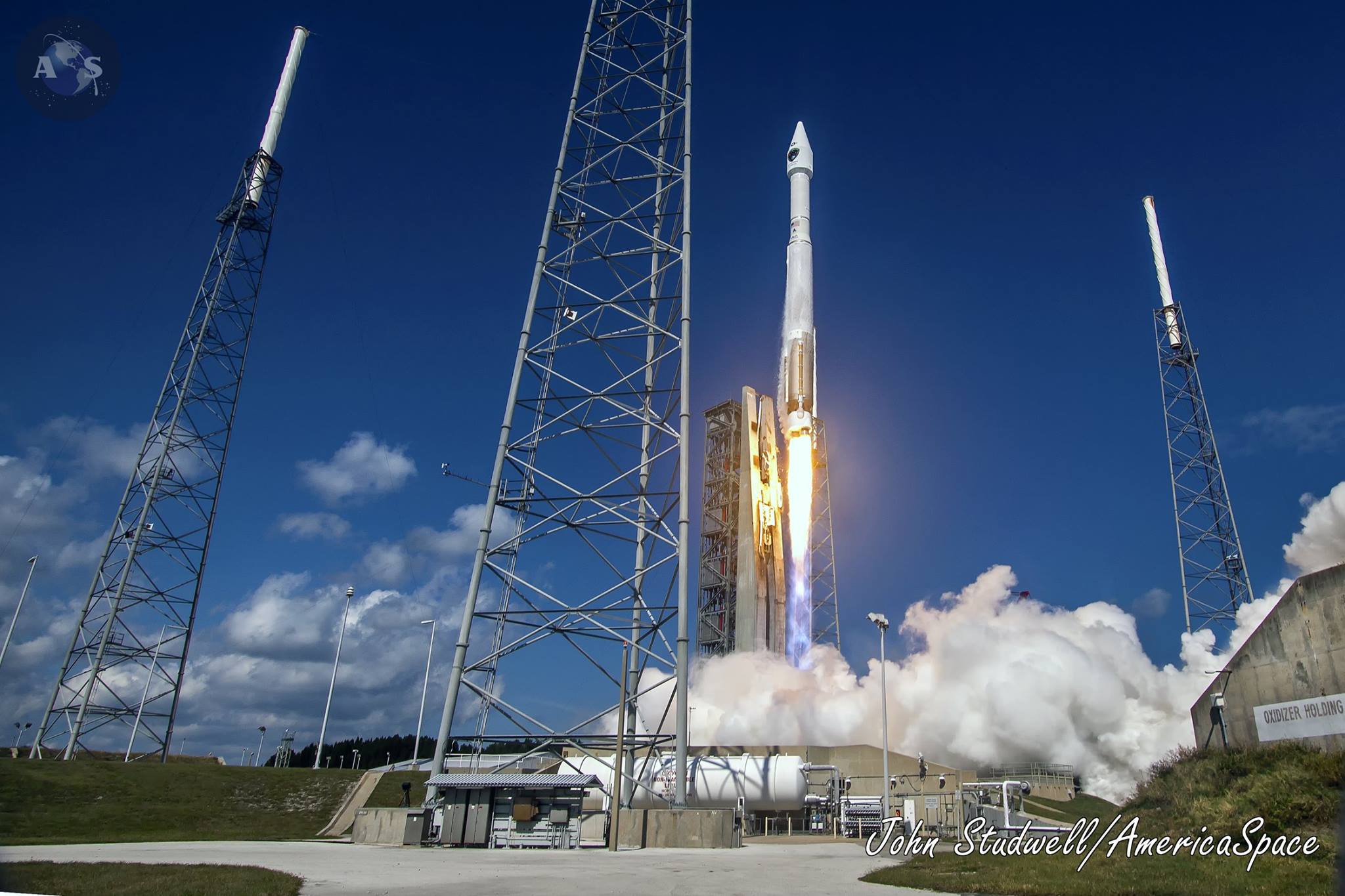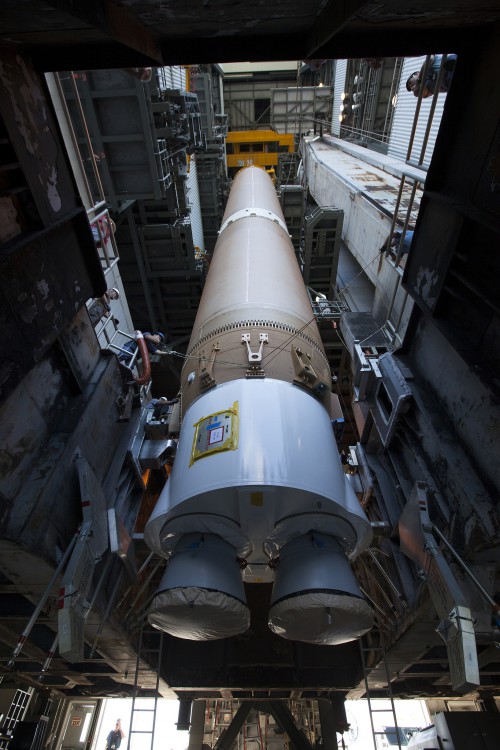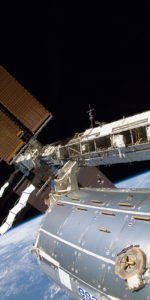
The U.S. Air Force believes that United Launch Alliance (ULA) had options that would have allowed it to bid on the initial GPS III launch in 2018, but, given ULA’s RD-180 engine supply, the company has decided instead to cede that launch to Elon Musk and his Hawthorne, Calif.-based launch services competitor SpaceX.
ULA believes to compete for future military space launches it must be able to procure additional Russian RD-180 rocket engines for its Atlas-V launcher, which it believes it cannot do under the current budget and policy.
The USAF issued a GPS III Launch Request For Proposals Sept. 30, with responses due Nov. 16 (yesterday).

Instead of responding to the RFP the company said today, “ULA wants nothing more than to compete, but unfortunately we are unable to submit a compliant bid for GPS III launch services.”
“The RFP required ULA to certify that funds from other government contracts will not benefit the GPS III launch mission,” said ULA. “ULA does not have the accounting systems in place to make that certification, and therefore cannot submit a compliant proposal.”
AmericaSpace had already reported weeks ago, on Oct. 29, that ULA Chairman Tory Bruno said then that ULA would not bid on the GPS III launch contract, leaving the Air Force with SpaceX as the sole launch provider for GPS III and other military space payloads. The Air Force did not want that to happen.
In an earlier conference call with reporters, the newly appointed Claire Leon, who heads the Launch Enterprise Directorate at the Space and Missile Systems Center in Los Angeles, Calif., said ULA could indeed bid by:
- Reallocating Atlas V Russian RD-180 engines now intended for non-military missions. But ULA did not want to do that due to other contractural obligations.
- Await Congressional relief from a defense secretary ban on RD-180s, an option that never really developed.
- Or obtain a National Security Waiver from the ban on Russian RD-180s.
According to Space Policy Online. the Defense Department then in mid October decided to withdraw the offer of a waiver.
“The Department of Defense (DOD) has decided not to issue a waiver from current legal restrictions on the number of RD-180 engines the United Launch Alliance (ULA) can obtain to launch national security satellites,” said Space Policy Online.
“Deputy Secretary of Defense spokesperson Lt. Cmdr. Courtney Hillson pointed to several restrictions,[affecting that decision] including legal constraints, that are complicating DOD’s efforts to ensure it has two sources of launch services.”
According to Space Policy, “he said the 2013 National Space Transportation Policy reasserts long standing guidance that the Secretary of Defense ensure, ‘to the maximum extent practicable, the availability of at least two U.S. space transportation vehicle families capable of reliably launching national security payloads.’”
ULA’s move will hand the initial GPS III launch in 2018 to SpaceX, but it will also pressure the U.S. government into freeing more RD-180 procurements or risk a SpaceX accident or other difficulty with no backup other than the tremendously more expensive Delta IV rocket, which has launched GPS-2F satellites in the past.
ULA said the Air Force GPS III launch solicitation “allows for no ability to differentiate between competitors on the basis of critical factors such as reliability, schedule certainty, technical capability and past performance.”
Meanwhile, another Atlas-V booster is already standing vertical and being readied to launch Orbital ATK’s new enhanced Cygnus spacecraft, named the Deke Slayton II, for a scheduled Dec. 3 flight on the OA-4 mission to deliver over 7,000 pounds of cargo and supplies to the International Space Station for NASA.
BOOKMARK our Cygnus OA-4 “Mission Tracker” for regular updates and LIVE COVERAGE from Cape Canaveral on launch day.
Be sure to “Like” AmericaSpace on Facebook and follow us on Twitter: @AmericaSpace
.
Missions » GPS » Missions » GPS » GPS 3 »





“We are taking our rocket and going home!”
Lost monopoly on launches. Check.
Too stupid or greedy to develop an alternative to the RD-180. Check.
Now playing a poor game of chess to get their way. Check
Go get ’em SpaceX!
“Too stupid or greedy to develop an alternative to the RD-180. Check.”
Weaning from the RD-180 is something that should have happened a long time ago. It didn’t because it’s an excellent engine at a good price.
I’m glad to see that congress has said no to the RD-180 and ULA is working on a replacement booster and partnered with a supplier developing a replacement engine. But, congress has put an unrealistic cap on RD-180 use. Development and integration of the replacement can’t happen overnight. Putting the RD-180 ban in place with a time frame that is unrealistically short for development of its replacement knocks ULA out of the ability to supply launches and destroys significant benefits brought by the appearance of SpaceX – competitive pricing and launcher redundancy.
It’s poor policy to strangle the goose that lays the golden egg.
Why doesn’t ULA offer the Delta 4?
The Delta 4 RS68 engine is reported to cost 2/3 of the Atlas 5 RD180 engine.
So the Delta 4 should be less expensive than the Atlas 5.
I wouldn’t get too revved up on SpacesX; too many engines on their rockets, reuse-ability program looks more like publicly stunt; same goes for their methane engine (Russians developed them years ago and don’t use them).
Cost. Delta IV is actually more expensive to launch and the ULA would not win based on the price.
The price of a Delta IV Medium launch is about $164 million.
Atlas V 401 is less than $100 million per launch.
http://breakingdefense.com/2014/05/ula-fires-back-at-spacex-at-space-symposium-details-launch-costs/
ULA haven’t invested in making the Delta IV less expensive. Which happens when one company controls both of the main launchers to orbit. They chose to go with a foreign sourced engine supplier and make that rocket less expensive. Who’s to say, that, if the Delta IV medium had been equipped with more powerful solid rockets, in clusters of up to 6, then, it would’ve had the same performance as the Atlas V. Of course the Delta IV Heavy version is an expensive rocket, and it profits ULA to sell it to the DOD. So, what’s the point in pursuing a less expensive version of it. It wouldn’t be in ULA’s business case to do so.
Concerning SpaceX performance, it would be a good idea to look at their past performance.
Note this from Jim Hillhouse in Space News.
http://spacenews.com/letter-bolden-has-short-memory-on-changing-space-policy/
I found these quotes particularly interesting:
(1) In early 2011, because the Commercial Orbital Transportation Services (COTS) program had spent to its contract ceiling of $500 million, and with neither of the two contractors, SpaceX or Orbital Sciences, within another two years of sending anything into ISS, NASA had no choice but to bail out the COTS contractors with $239 million, nearly 50 percent over the original COTS contract.
(2) And today, with public records showing that the follow-on Commercial Resupply Services (CRS) program has been paid nearly up to the contract ceiling of $3.5 billion, and with not even half the launches completed, it’s looking increasingly as though a bailout of the CRS contractors will be needed at some point.
(3) Although Bolden calls COTS and CRS successes, one is left wondering how many more of his successes NASA can afford.
Hilarious.
Hi John,
Considering SpaceX
(1) Started out claiming they would deliver ISS cargo for $9,500/kg.
(2) Then when they signed the CRS contract it became $80,000/kg.
(3) Now is looking something like $160,000/kg.
I am not sure most taxpayer would consider it hilarious.
Still, you sometimes have to laugh to keep from crying.
John,
The joke is on CRS, which has already nearly spent to the contract ceiling but with over half the flights remaining. NASA has no clear explanation as to how it’s going to solve the two-point boundary value problem it currently faces with CRS. Oh, technically, under the CRS contract the contractor is supposed to make-up any lost launches.
Now, for cost-effectiveness of CRS, just do the numbers. $3.5 B / 40 mT = $87,500 / kg; SpaceX is $80,000/kg and Orbital’s is 95,000/kg.
Specific to SpaceX, yes, the payload cost of a SpaceX Falcon 9.1 launcher is $65 M/13 mT = $5,000/kg. The other $75,000/kg is the cost of getting the payload ready, the code and craft ready for ISS rendezvous, and goodness knows what else.
Oh, perhaps many have forgotten that NASA is out over $100 million in lost cargo, some of which like the IDA and EMU will be pricey to replace.
Here are some numbers for other systems:
Shuttle-
At the end of the Shuttle program NASA was paying $2.4 B/year to own it, and $300 M/flight, for up to 4 flights/year. It could take 20 tons of cargo to ISS. So, in any given year you could get 80 tons of cargo to ISS for $3.6 B. Those were actual numbers. Rounded up to $4 B, that’s $25 K/lb, or $55 K/kg, all-in. Oh, and you also got crew for that price.
SLS
Assuming the cost of $2.4 for support that the Shuttle required, and noting that the variable cost for the SLS Block I that has a LEO payload of 70 mT (it’s actually more like 85 mT now, but let’s not quibble), which I’ll assume has a $500 M variable cost, total launch cost is $3.1 B, but let’s make it $3.5 to keep the math simple, so that launcher’s payload to LEO cost is $50,000 /kg.
For the SLS Block II that has a LEO payload of 130 mT (now more like a 145 mT, but again let’s not quibble), which I’ll assume has a $700 M variable cost, so a total of $3.3 B, but let’s make that $4 B to make the math even simpler, the payload to LEO launch cost is $31,000 /kg.
Still laughing?
Well, I’m not. The rush to privatization of NASA’s LEO mission is costing the agency.
“Oh, technically, under the CRS contract the contractor is supposed to make-up any lost launches.”
Hi Jim.
Good analysis.
Here is a little more, SpaceX has flown 6 of the 12 contracted CRS flights and delivered about 48.5% of the contracted payload; but apparently is being paid the whole total price of the contract. That comes to $164,700/kg, as of now.
A question about the quote above, does anyone really believe they are now going to complete their contractual obligations with out being given more money?
Joe,
“Oh, technically, under the CRS contract the contractor is supposed to make-up any lost launches.”
I am not aware ….Has SpaceX already requested additional funds? Is NASA requesting additional funds for the First CRS contract? Were there options for additional funds based on expenses above Base Launch cost such as processing or secret DOD cargo that became a need?
Tracy,
Those are the kind of questions as was implying in my question to Jim.
I do not know, except to say I do not think NASA (through the CRS contract) would be putting up “additional funds based on expenses above Base Launch cost such as processing or secret DOD cargo”. DOD cargo (if any to the ISS) would seem to be the DOD’s responsibility.
As we have already reported previously, NASA won’t say how much additional $$ is involved with extending the first CRS contracts. That also means of course that neither will Orbital ATK & SpaceX…
Thanks Mike,
If I interpret that correctly, it means we do not know how much more it is going to cost to fulfill the terms of the original CRS contract obligations.
As noted above the taxpayers should not be laughing, not only about the extra expense; but about being kept from knowing the details.
Joe and Mike,
How can NASA not provide the additional dollar amounts if required with extending the first CRS contracts? Shouldn’t that be public information? I am confused is NASA already saying additional dollars have been spent or will be spent ..but not how much?
Tracy,
If a understand what Mike reported, NASA may be intending to “provide the additional dollar amounts”; but will not say if they are (and if they are how much). In a sane world a commercial provider would not be given more money to fulfill a contract they underperformed on, in the real world who knows.
The information should definitely be public, but while they may not have the right they may have the power to keep it secret.
A cynic would suspect the extra money would come under the cover of being for additional flights, but then be used to finance the original unperformed flights. Then later another extra amount of money can be requested to finance the “additional flights”.
Welcome to the brave new world of crony capitalism.
From the Spaceflight Now article http://spaceflightnow.com/2015/03/07/nasa-orders-missions-to-resupply-space-station-in-2017/
“NASA has ordered three additional flights with SpaceX in the extension period,” said Stephanie Schierholz, a NASA spokesperson. “NASA has ordered one additional flight with Orbital in the extension period. This is based on the projected needs of the ISS program for cargo upmass, return and disposal and the unique capabilities of each contractor.”
“Shierholz declined to release the value of the contract modifications, saying the data is sensitive.”
“SpaceX and Orbital ATK’s original contracts, which included mechanisms to add more missions, had “not-to-exceed” values of $3.1 billion each. That value does not change with the extra missions, Schierholz said.”
From the Spaceflight Now article http://spaceflightnow.com/2015/03/07/nasa-orders-missions-to-resupply-space-station-in-2017/
I remember reading in another article that any additional CRS missions would include inflation of up to $20 million per launch. I will keep looking for it. The original contract for SpaceX was approx. $1.6 billion ($133.3 million/launch for 12 launches) and for OATK $1.9 billion ($237.5 million/launch for 8 launches).
Happy Thanksgiving
Had not read this article when at(November 20, 2015 at 2:28 am)I wrote:
“A cynic would suspect the extra money would come under the cover of being for additional flights, but then be used to finance the original unperformed flights. Then later another extra amount of money can be requested to finance the “additional flights”.”
Sort of like kiting checks.
Whoops, that should have been – at November 19, 2015 at 1:24 pm.
Will each launch request for bid just have one bidder? Are they just going to take turns…Taking the Bid? Is the Delta 4 RS68 engine Really at 2/3 the cost of the Atlas 5 RD180 engine and an equal replacement? Is this what competition looks like in the future for Military Launches? It certainly does look like corruption rather than competition.
“Is the Delta 4 RS68 engine Really at 2/3 the cost of the Atlas 5 RD180 engine and an equal replacement?”
I don’t know it’s price, but it is not an equal replacement. From a flight control perspective it’s quite different (one nozzle to gimbal instead of two) and it uses a different fuel. It would not replace RD-180 on the Atlas V.
While ULA could bid with the Delta IV, they won’t because the Delta IV is a much more expensive rocket overall and they aren’t going to spend the money on preparing a bid for a contract they know doesn’t have a hope of winning because it’s so much more expensive than their competitor.
Also, it’s not in ULA’s business case to bid the Delta IV.
“Is this what competition looks like in the future for Military Launches? It certainly does look like corruption rather than competition.”
Yikes! That’s what I was thinking.
Maybe a modified Delta III could be useful.
Add a reliable second Rocketdyne RS-27A main engine to the Delta III.
Stretch the length of the standard Delta III’s four meters in diameter kerosene tank and add a new four meters in diameter liquid oxygen tank.
The upper stage could be a stretched Delta III second stage with a single hydrolox Pratt and Whitney RL10B-2.
Add whatever large solid rocket boosters that are needed for a given payload mass.
Eventually, modernize, simplify, improve, and reduce the cost of the Rocketdyne RS-27A engine that currently has a Sea Level Thrust of 890.1 kN, or 200,102 lbs, of thrust.
Note that the original Delta III was capable of putting a 8,290 kg or 18,280 lb payload into LEO or putting a 3,810 kg, or 8,390 lb, payload to into GTO. A stretched 4 meters in diameter dual RS-27A powered Delta III could be a much more capable launcher.
If needed, a version of this stretched and 4 meters in diameter Delta III with three or four reliable RS-27A engines would also be doable.
If a five meters in diameter Delta III were developed, the first stage could have five or six RS-27A engines.
Another engine option for such a four or five meters in diameter Delta III would be an economical single F-1B rocket engine with 1.8 Million lbs of Sea Level thrust.
Note that if four first stages of such a four meters in diameter F-1B powered Delta III were connected in two pairs and used as substitutes for the SRBs of the SLS, it should result in a SLS launcher with about a 150 metric tons of payload to low earth orbit.
That might be useful!